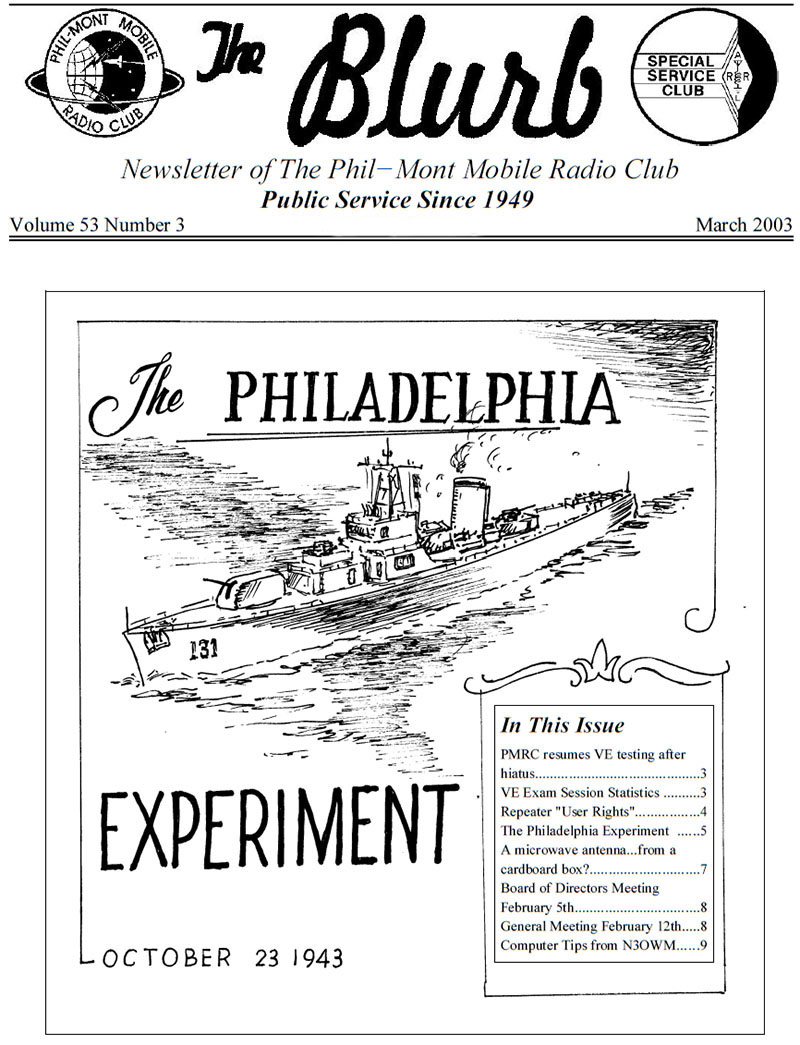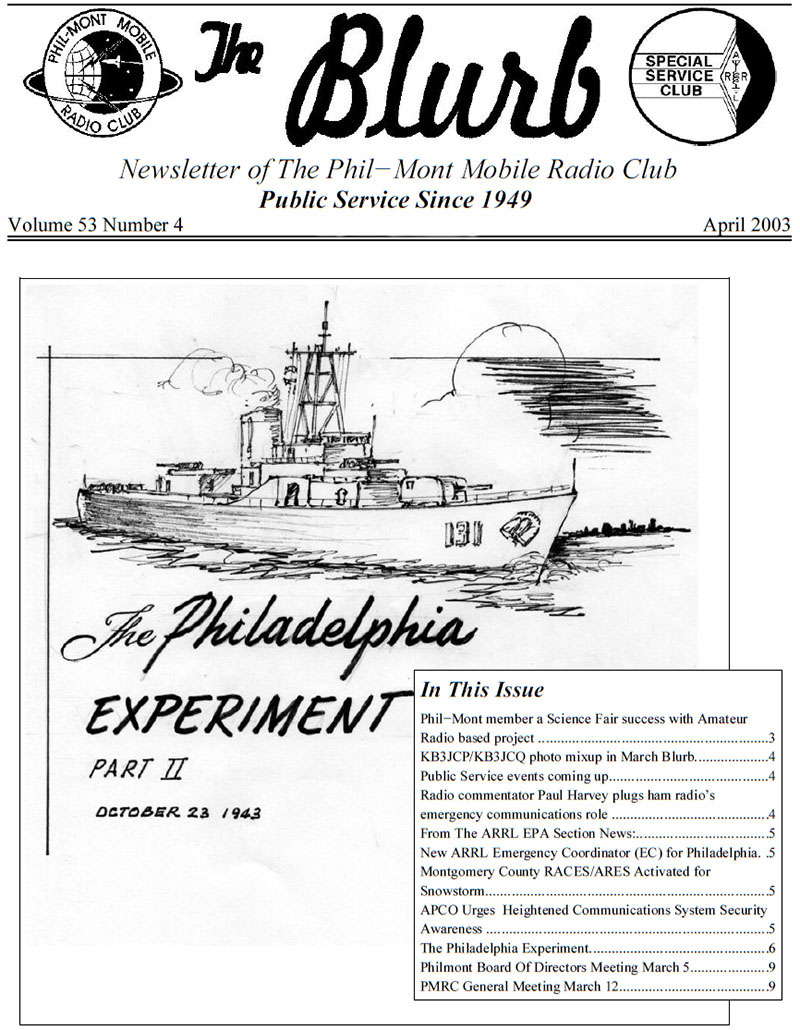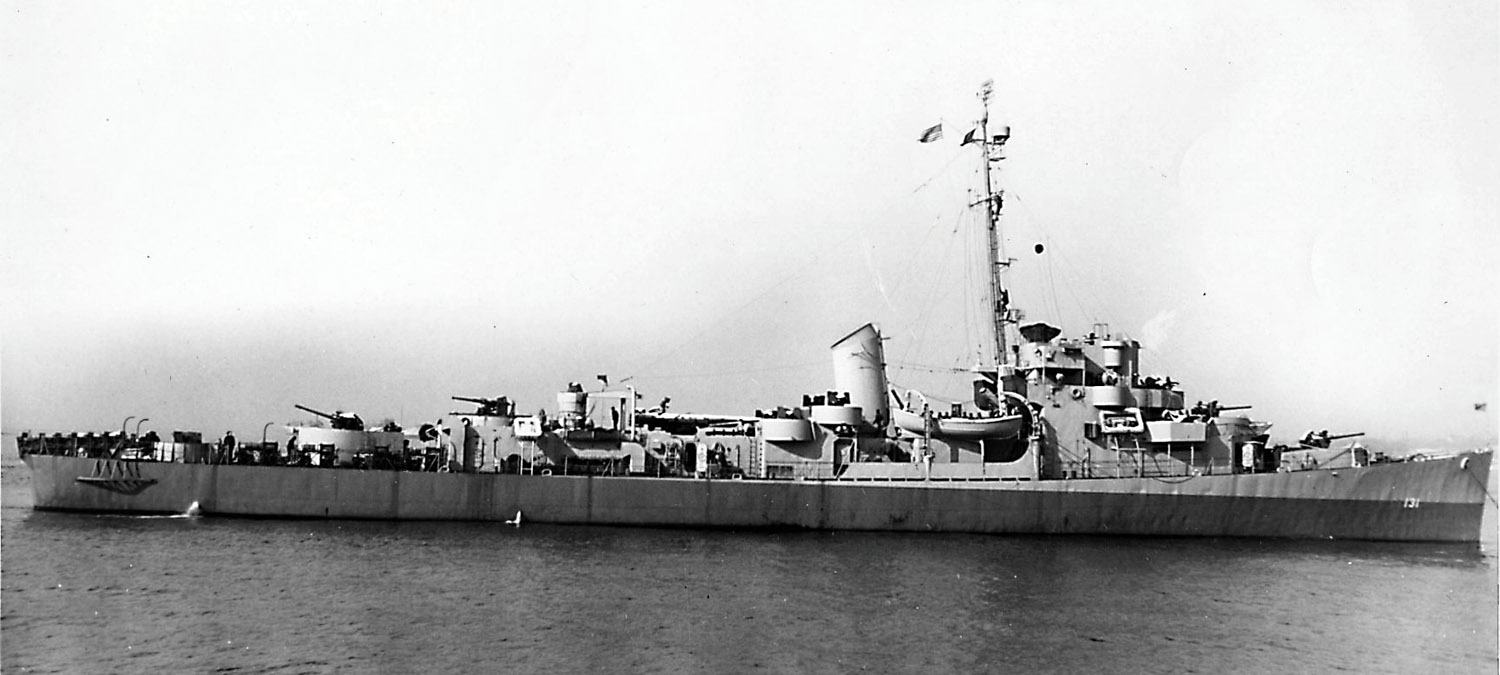
The Philadelphia Experiment by Sam Kuncevich
Originally published in The Blurb, March 1989
Part 1
For those who have never heard of the so-called “Philadelphia Experiment”, briefly it’s all about an experiment at the Philadelphia Navy Yard, based on Einstein’s “Matter to Energy, Back to Matter”. The experiment as reported, was about a ship (at the yard) that was teleported to Norfolk, Virginia and back again. The time element, uncertain, but not important. I will give you the facts as I found them; you decide if it happened or not. The Navy, obviously, says it never happened.
I first learned about it in 1958, from an article published in Fate magazine. They said it was witnessed by crew members of a cargo ship in Norfolk harbor. They were part of the crew of the SS Andrew Furnseth waiting at anchor to off-load a cargo at Norfolk.
One of the crew was a man named Carlos Allende, a native of Mexico, so his papers claim. He also lived, part time, in Reading PA. He carried two Social Security cards, Carlos Allende and Carl Allen. Allende or Allen claims to have witnessed the sudden appearance of the DE class ship USS Eldridge DE-173 during the morning of October 23, 1943. And, after several minutes, fade from sight. He also claims that the ship came from the Philadelphia Navy Yard and back in a matter of minutes. He does not clearly explain how he knew the ship came from Philadelphia as a part of the experiment.
He later sent in a series of letters, in regard to that experiment, to a Dr. Jessup, a friend and associate of Dr. Albert Einstein. Those letters were examines and notations made, by Dr. Jessup and his staff.

The letters were copied and put together as a small manuscript; only eight copies were made. After the sudden and mysterious death of Dr. Jessup and the disappearance of several of his staff, these papers were release and became known as “The Allende Papers”.
At this point in time of my research, 1965, and the names I now give, have given me an OK to use, or they are deceased. Being employed at the Shipyard during this time, up to 1982, I was in a position to go into some shipyard records and files to find anything relating to the October 23, 1945 date–a Saturday–or to the USS Eldridge DE-173.
I found a listing of all the ships that came into the Navy Yard in 1943, including the date of arrival, to what pier or drydock that ship was located, the nature of the work (repair, overhaul or conversion) and the date of departure. The listing indicated that the USS Eldridge was not in the shipyard in 1943. I assumed then it was another ship, not the Eldridge. Checking the list again, I found the USS Hammann DE-131 came into the yard October 20, 1943, was berthed at Pier A, back channel, and no record of the purpose of arrival or nature of work, and no departure date! Unusual to say the least.
Official Navy records show the USS Eldridge was later sold to the Greek Navy, but no record agreed on what was the future of the USS Hammann. One record said it was mothballed at a Texas ship reserve station. Another located it at Little Creek, Virginia. Still another said it was sold to Greece. Another interesting fact was that the USS Hammann was originally named Langley and was renamed prior to coming to the Navy Yard. This, too, is unusual.
This now convinced me that the ship in question was not the Eldridge but the USS Hammann. My search of the records uncovered another unusual fact.
On the supposed date of the experiment, October 23, 1943, at all shops and offices on that day, a Saturday, the back channel employees were assigned work in other locations or given the day off. Most unusual for a wartime shipyard. This fact was verified in conversation with a now retired and deceased member of Liaison Group, Jimmie Judge.
Some years later, ten years to be exact, not much progress was made in my research. In 1968 the USS Sullivans incident took place in the shipyard’s back channel. The Sullivans, a “Mothball” ship, was undergoing it’s regular inspection below main deck, checking for water, checking the dehumidifiers and the lighting system. This work is done by Navy personnel who go aboard ships and make the inspections as required. On that day of the Sullivans’ inspection, three sailors went aboard by way of an access hatch on the weather deck aft. As the last man went aboard and made his way with a flashlight he heard the access hatch slam shut. The first one who went below was on the second level down at the forward end of the ship. He was shaken first by the swish of an object “thrown” by his ear and the clang of a door-dogging wench clattering against a bulkhead. Needless to say, they all left the ship rather hurriedly. The word got out to the news media and the story made headlines of “The Ghost Ship at the Yard”.
There was mention made about the ship’s log book in storage at the yard. Out of curiosity, I called the reserve fleet to ask if the log book of the USS Hammann was in storage here and was it available for viewing. I spoke to a Chief Boatswain’s Mate Hansen who then referred me to a Commander Hebner. The reply I was given was that I needed a letter from the shipyard commander stating a “Need to Know”. That ended my search for the logbook of the Hammann
Several days later, June ??, 1968, I got a phone call from the shipyard security office at Building 695, requesting my appearance as soon as possible. I reported to intelligence office Captain William Glencoe, who questioned me about the ship’s log book of the Hammann. I explained that I was doing research on the Philadelphia Experiment, that I knew very little about the story. He said I can go back to work and he would contact me again in a few days. The following week I was called again to report to the office and was handed an opened letter. It was from the Office of Naval Intelligence.
It was addressed to Captain Glencoe and it specified that “I, the researcher, was to discontinue further research of the Philadelphia Experiment”. The letter was taken back and placed in a file. Now I have no proof of the Navy’s objection to my research.
The following Monday, when I got back to my drawing board, I found my files and drawers had been searched. Was I being search for research material, or just ransacked by the night janitors? From that time I kept no records of my work.
…to be continued
Sadly Sam Kuncevich (N3QIE) past away on November 7th, 2004. He was a long time (joined in 1980) contributing member of Phil-Mont Mobile Radio Club, Philadelphia, Pa.
Part 2
Months later, I stopped at a local diner for lunch, after some Saturday morning shopping with my wife. We were sitting at a booth and placed an order with the waitress, when a casually−dressed elderly man came in and sat at the counter about seven feet from our booth. He placed his order and sat with his head down, mumbling to himself. Then, suddenly, out loud he said “The back channel, the 30 ft channel, they all disappeared!” It obviously drew my attention and I watched and listened carefully, when he suddenly got up and walked out. All the waitresses said they never saw him before. Looking around outside the diner I found no trace of him. I had no idea which way he had gone. A week later I stopped by and asked if this person had shown up again. He hadn’t. Now I was puzzled! Was I being baited, or was this a witness to the 1943 event? As time passed, I got to know the Navy Yard Chief of Police, Chief Bill Everett. When the time was right I stopped in to see him and told him of my research and asked if any of his staff were on duty in October 1943. He checked his file and found Joe Symzack, Patrol Sergeant, who happened to be a high school classmate of mine from Central High School. There was another, Sgt. George Leslie. Both were assigned duty to a restricted area of the back channel. Both had witnessed the arrival of a flat−bed truck bringing in a large canvas−covered object through the security line to Pier A.
This was a Saturday morning, but he did not recall the October date. Jo Symzack says he remembers a black car arriving ahead of the truck, and a stoop−shouldered, elderly man who left the car and walked in the direction of Pier A.

This description, however, does not throw any light on the story.
In 1970 I was transferred from the Design Division of the ship yard to the Destroyer, Cruiser repair and overhaul group located at the east side of the Naval Base. The “Old” aircraft side.
Some time later, a book was published called “Thin Air”. It is supposed to be based on the Philadelphia Experiment, but was pure fiction. The recent movie “The Philadelphia Experiment” was based on that book. Once again, however, a curious fact was present. The book “Thin Air” gives a list of credits: people who provided information to the authors. You will find that list at the front of the book. It gives the name of Chief William Liedke, who I knew very well, having worked with him on several public relations projects. The Chief was discharged from the Navy six months after the book was published. I saw that discharge; it stated: “For the best interests of the Navy”. A federal lawyer failed to get him reinstated.
By 1978, I had a few more curious facts added to my file. These I will not tell now. By this time I got to know a Mike Keiser, 1st class journeyman, at the Pubic Information Office Building 6. He told me that had a locked file of letters regarding the “Experiment”. I managed to make copies of those letters to add to the file of research. These too, I will not include here. Another book came on the market written by Charles Berlitz, who goes though a lot of documentation but no facts or conclusive evidence. The book is titled “The Philadelphia Experiment”
Reprinted With Permission.
On a trip to New York City with a partner on research projects, Frank Burghart stopped in one of the New York bookstores and found a softback publication “hidden” behind other books on an uppermost shelf. On reaching the first page, the book was immediately purchased, it was an original copy of “Allende’s Papers“.
You can be sure this is kept in a secure safe place. In one of Allende’s letters to Dr. Jessop, he states that on the night of October 23, after the experiment, several sailors stopped at the Stadium Bar at Broad and Snyder Aves. (still there). After sitting at the bar for an hour, the sailors suddenly became rowdy and started fighting with the other customers. In the midst of the melee, two sailors literally walked though the wall and disappeared outside. The story was published the next day in one of the Philadelphia newspapers. This could not be found. At that time the newspapers were The Record, The Evening Bulletin, The Ledger, The Inquirer and the Daily News. Papers of October 23−24 1943 would be almost impossible to find, even on microfilm. It is, however, a matter of record. The bartender at the time had committed suicide. Two waitresses were hospitalized with nervous breakdowns.
According to Allende at the time of the experiment, a “skeleton” crew and some civilian technicians were on board the ship. The event was described as follows:
When the signal was given to conduct the experiment, the fore and aft lines were released. A slow hum from the shipboard object, similar to a large electric generator, gradually rose to a high pitch and to an almost inaudible whine
Within several minutes, parts of the ship began to fade, then the hull, showing a depression in the water below, and in a few minutes it too had vanished, then reappearing some minutes later. Some of the crew, however, were completely dazed and disoriented and some only partly visible. Something had gone wrong. Incredible? Yes…how about a statement from one of the crew who was aboard, an officer who volunteered to take part.
“They were trying to make a ship invisible. It would have been perfect camouflage if it had worked. And it did, too, for the ship. But for those of us on board, it didn’t work too well. We couldn’t stand the effects of the energy field they were using. It did things to us.
“I should never have taken that assignment. It was top secret, and I could have backed out. I was told later that several had died. I never saw any of them again. Those that survived, they just let us go. Discharged as mentally unfit.”
That statement was taken by two Air Force officers at Colorado Springs. The Air Force officers were James Davids of Baltimore MD, and Allen Huse of Houston TX. They had relayed this information to William Moore, the co−author with Charles Berlitz of “The Philadelphia Experiment”. I was told by Harry Concsello, retired, of Design Division at the Navy Yard, a center−city favorite spot for sailors ashore was a place called “The Peanut Gallery”. It was closed down by the Navy because it was a spawning place for rumors and talk about the Philadelphia Experiment.
Well, that’s about it. There is more I can give you, but I think I’ve covered the more important details.
Sam Kuncevich (N3QIE)


